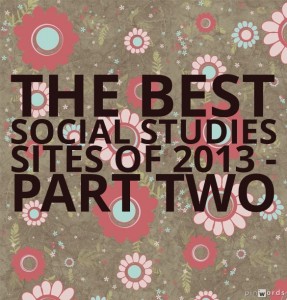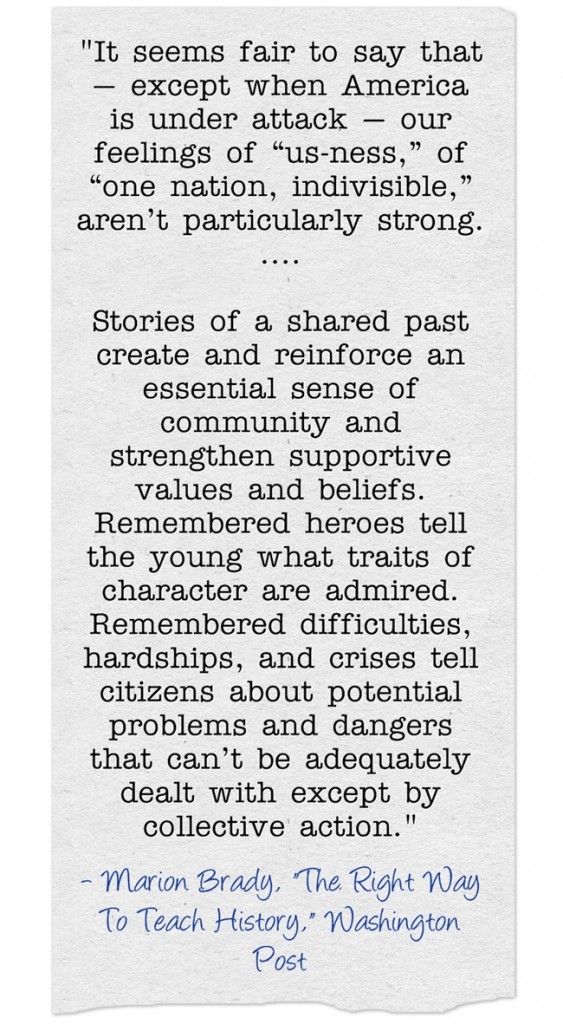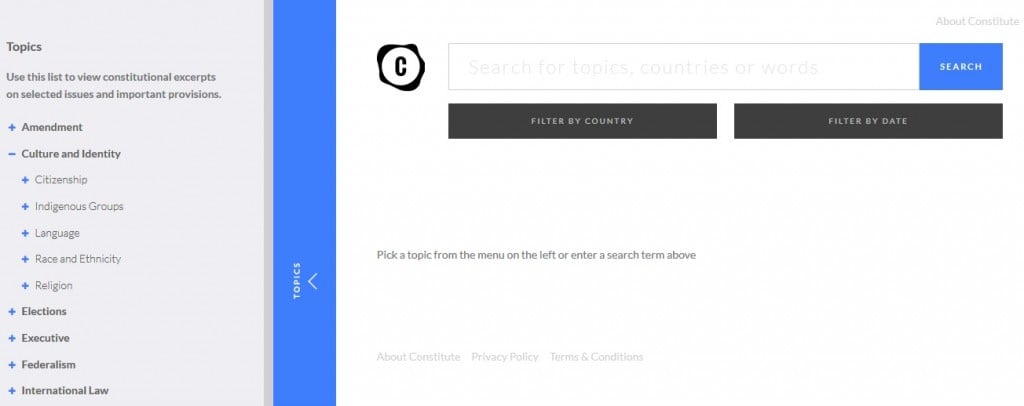The annual “Best…” lists continue….
You can see my picks for the first six months of the year at what functions as Part One of this list: The Best Social Studies Sites Of 2013 – So Far.
You might also be interested in:
All My 2013 “The Best…” Lists (So Far) Related To Social Studies In One Place
The Best Social Studies Sites Of 2012 — Part Two
The Best Social Studies Sites Of 2012 — Part One
The Best Social Studies Sites Of 2011
The Best “The Best…” Lists Related To Social Studies — 2010
The Best Social Studies Websites — 2010
The Best Social Studies Websites — 2009
The Best Social Studies Websites — 2008
The Best Social Studies Websites — 2007
Here are my choices for The Best Social Studies Sites Of 2013 – Part Two:
The Guardian has published an excellent, though sad, interactive titled Why are we building new walls to divide us?
The PBS News Hour collaborated with the U.N. World Food Programme to create some terrific resources for World Food Day on October 16th.
I’ve previously posted about how I use the United Nations Declaration of Human Rights, and other resources, in a lesson on the Bill of Rights.
Zen Pencils has just created this excellent infographic of the Declaration — with simplified language — which is a great resources for that kind of lesson:
The right way to teach history i the title of a new post at Valerie Strauss’ post at The Washington Post. It’s by Marion Brady, and I plan on using the post itself in my IB Theory of Knowledge class — he shares an insightful perspective on the purposes of studying history.
Here’s an excerpt:
In addition, at the end of his post, he shares a link to his American History Handbook, which is a free book he’s written with pretty decent lessons, including all student hand-outs, in United States history.
Constitute has been created by the University of Texas at Austin and funded by Google, and provides an easily searchable database of the constitutions from 160 countries. The really extraordinary feature is the ability to search for common themes (click “browse topics”). I’ve embedded a screenshot of what that page looks like below, just to give you a taste of the site’s possibilities:
If you, like many other teachers, have used a version of the well-known Rethinking Schools lesson on the constitution and the Bill of Rights (I provide students excerpts of the United Nations Declaration of Human Rights and the South African Bill of Rights, have students compare them our own, and then students develop one for their own imaginary country — with justifications), then you can see how valuable a site like Constitute could be. It’s ability to easily search can enhance that lesson, as well as others, by letting students do a much more in-depth comparison to multiple nations.
Here’s a video on Constitute:
Income Upshot comes from Marketplace, the group that produces a number of financial-related programs for public radio.
You input your income and area code, and then it feeds back a lot of interesting information about what people with your income — both locally and nationally — do.
This is one impressive video, and I’m adding it to The Best Websites For Teaching & Learning About World History:
The Guardian has published an excellent infographic titled What happened to history’s refugees? It charts some of the largest “human movements” in history, starting at 740 BC and ending at today.
Poverty and Race in America, Then and Now lets you look at any metropolitan area in the United States and compare poverty in it in 1980, 190, 2000 or 2010. You can view the comparison on a “sliding” map, though I wish it just showed you the same locations in two screens — that would make it a little easier to compare to the two views (you’ll see what I mean when you visit the site).
Here are two new interactives I’m adding to The Best Resources About Wealth & Income Inequality:
Inequality.is is an extremely impressive interactive.
Growing Apart: A Political History of American Inequality includes many interactive charts.
Wonderground is a game from General Electric where you visit various cities in The United States and are given “missions” to explore them and make discoveries related to science and history. It would be accessible to high Intermediate English Language Learners and others, and it’s very engaging.
The Best Resources For Learning About The Birmingham Church Bombing
The Best Sites For Learning About The Battle Of Gettysburg
The Best Resources For Understanding The Debt Ceiling
The Best Sites For Learning About Brazil
The Best Sites For Learning About Italy
The Best Resources For Learning About The Fire Near Yosemite Valley
The Best Resources On Malala Yousafzai
The Best Resources About The March On Washington
The Best Resources To Help Understand The Federal Government Shutdown
The Best Online Resources About President John F. Kennedy
The Best Online Resources For Learning About The Gettysburg Address
The Best Resources For Learning About Typhoon Haiyan
The Best Resources For Learning About The Fires In Australia
The Best Resources For Learning About Teens In The News
“Wide Angle: Window Into Global History” is a project of Channel Thirteen in New York. It has a collection of multimedia social studies lessons and a “video bank,” which I think is particularly impressive. The videos are divided by themes (power, conflict, migrations, etc.) and each video has suggested guiding classroom questions, a transcript and more. I’m finding that the page they have listing the videos “by location” particularly useful for my Geography class.
Q & A Collections: Teaching Social Studies is my newest post at Education Week Teacher. It brings all my social studies-related Ed Week posts together in one place.
I wrote a New York Times post for English Language Learners is on protest movements and using historical photos for language development. It includes a student interactive.
Learn about John F. Kennedy, the past tense, and how to use inductive text data sets with English Language Learners in my NY Times post for ELLs. A student interactive is included.
Here’s my New York Times post includes 9/11 teaching ideas and a student interactive quiz for English Language Learners.
You can also see all my past Times’ posts here.
You might also be interested in seeing all 1,200 of my “The Best…” lists.







I am the Director of middle school history and social studies in a small suburban community outside of Boston. We would like to know if you can send us some websites that feature geography and thematic topics. EG: Country maps that can be used to compare economic related topics such as natural resources, income distribution, guns vs. butter, education, industrialization, economic range etc.
These would be maps that could be downloaded or copied in such a way that our students would find them easy to “read”
Thank you
Ann